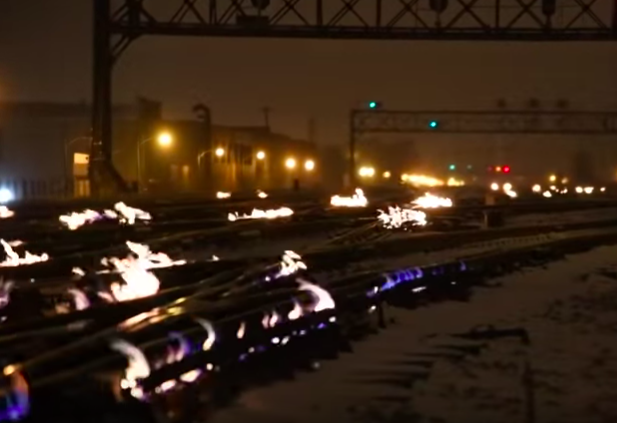With the Polar Vortex bringing deep subzero temperatures to Chicago the past few days, the commuter rail agency fired up the natural gas heaters to keep switches operative and free of ice. The heaters proved to be an eerie and irresistible visual backdrop for news outlets to illustrate how Chicago’s commuter railroad was coping with the deep freeze.
CNN reported: “When it’s this cold, Chicago sets its tracks on fire.”
United Kingdom’s Daily Mail: “Crews light Chicago tracks on FIRE to keep trains moving.”
“Chicago’s so cold they had to deliberately set the train tracks on fire,” said Colbert on his CBS talk show Wednesday night.
Not so fast, says Metra spokeswoman Meg Reile, who posted on Facebook: “Ok national and international media, repeat after me: we do not set the tracks on fire in Chicago. You are looking at gas-fired switch heaters. We have guys out there actually making sure the tracks don’t catch fire.”
Reile points out that the flames come from a gas-fed system that runs adjacent to the rails, generating heat on the critical areas where the switches are supposed to make contact. Without that contact, the switches default to a failsafe mode, and train movements are halted.
On Thursday, Reile says she heard from more a dozen media outlets from around the world, including Norway’s Dagbladet and BBC 5.
“Just crazy,” she noted.
Granted, the array of burners at the sprawling Metra interlocking near its Western Avenue yard is a dazzling sight. The burners there are critical to keeping more than 300 trains a day passing through.
And despite the media attention, the heaters aren’t just used in subzero cold. The system is turned on when temperatures are between 40 and 32 degrees Fahrenheit, and stays on when it’s below 32 degrees.
Chicago’s media sees the flames every winter and reporters know how the heating system works, but the out-of-town media loves to perpetuate the “tracks-on-fire” myth, Reile says.
Of all those reports, Reile credited Canada’s CBC Radio for reporting “Why Chicago’s commuter train tracks appear to be on fire.”
“CBC got it right,” she said.















A good Chicago Tribune reporter actually talked with a railroad employee and also got the story right.
This story shows why I like paying taxes to support the CBC.
Relevant to this news item here’s my own “In My Own Words” tale:
When I was a teen I was interested in trains but was not into it the depth of a “real railfan.” More specifically it was the late 1960’s and lived with my family on Long Island and had taken a few trips on the Long Island Rail Road, but never in snowy weather. One winter my sister, who was working and living in Manhattan at her first post-college job invited me to stay for the weekend and as no adults in the family were driving into “The City” I took the LIRR. As luck would have it a Nor’easter snow blizzard hit that weekend and I had to return at the height of the blizzard. Arriving at Penn Station I took an MP54 electric train to Jamaica for a change to a diesel train back to my home station out east on this dark winter late afternoon. As we snaked through Jay interlocking (west portion of the station complex) I registered a few seconds of shock and alarm as it appeared we going right through a giant field of fire, something I had never seen before live or in any publication. However in a few seconds I could figure out that the fires were all at the switch points of the giant and complex interlocking in order to keep them free from snow and ice. Ah-hah another interesting facet of railroad operation that contributed to my becoming (IMHO) a railfan, with a specific (but not sole) interest in railroad technology and operations.
Next thing ya know, the government will start lighting roads on fire instead of plowing them, or fund a million dollar study to explore that possibility
Instead of lighting the track burners, they should just use the media wonks to keep them free of ice. Because we know they are full of hot air.
Anther in “In My Own Words” tale: Once many years ago my girl friend and now wife were driving down Western Avenue under the A2 overpass during a slow moving traffic snarled snow storm. She noticed the “fire on the tracks” and want to call 911 to report the fire. I stopped her to explain it was normal operations.
Hot stuff. Anyone bring marshmallows & weiners for roasting?
I saw articles that said the fires were to keep the rails from contracting and breaking in the cold.
I made a point of correcting someone on Facebook that posted a video of the track heaters saying the track was on fire.
It’s the curse of “sound bite” journalism. All expedience, no information.
CBC probably got it right because they used to do the same thing in Toronto. Now they just use hot air blowers.
Actually Mr. Pins, it’s way beyond railroads. I cringe seeing a non-trade journal report about the business I’m in. I understand reporters wouldn’t know about details, but the way they act like accredited experts when they barely read a Wikipedia explanation of how stuff works…
So should we call this another example of “fake news?” Or another example of the abysmal ignorance of all things railroad that the non-railfan public and media wallow in? We all can cite other examples, like the Amtrak “commuter” train that passed over the bridge in Albany after it was struck by a runaway boat.